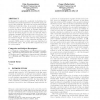Free Online Productivity Tools
i2Speak
i2Symbol
i2OCR
iTex2Img
iWeb2Print
iWeb2Shot
i2Type
iPdf2Split
iPdf2Merge
i2Bopomofo
i2Arabic
i2Style
i2Image
i2PDF
iLatex2Rtf
Sci2ools
MOBIHOC
2008
ACM
2008
ACM
Complexity of scheduling with analog network coding
In this paper we analyze the complexity of scheduling wireless links in the physical interference model with analog network coding capability. We study two models with different definitions of network coding. In one model, we assume that a receiver is able to decode several signals simultaneously, provided that these signals differ in strength significantly. In the second model, we assume that routers are able to forward the interfering signal of a pair of nodes that wish to exchange a message, and nodes are able to decode the "collided" message by subtracting their own contribution from the interfered signal. For each network coding definition, we construct an instance of the scheduling problem in the geometric SINR model, in which nodes are distributed in the Euclidean plane. We present NP-completeness proofs for both scenarios. Categories and Subject Descriptors F.2.2 [Analysis of Algorithms and Problem Complexity]: Nonnumerical Algorithms and Problems--Geometrical Proble...
MOBIHOC 2008 | Network Coding | Network Coding Capability | Network Coding Definition | Wireless Networks |
| Added | 24 Dec 2009 |
| Updated | 24 Dec 2009 |
| Type | Conference |
| Year | 2008 |
| Where | MOBIHOC |
| Authors | Olga Goussevskaia, Roger Wattenhofer |
Comments (0)

